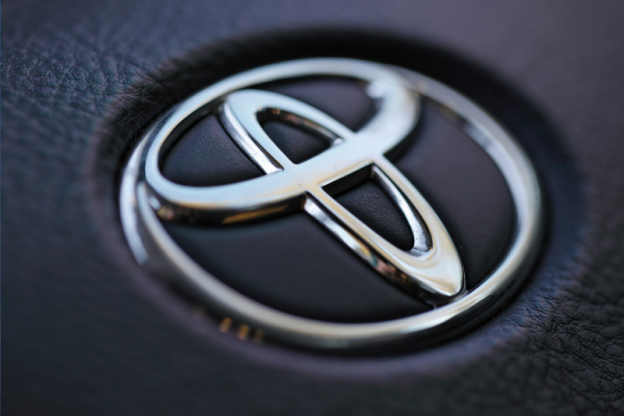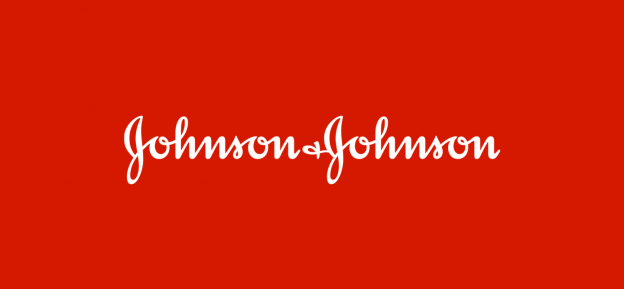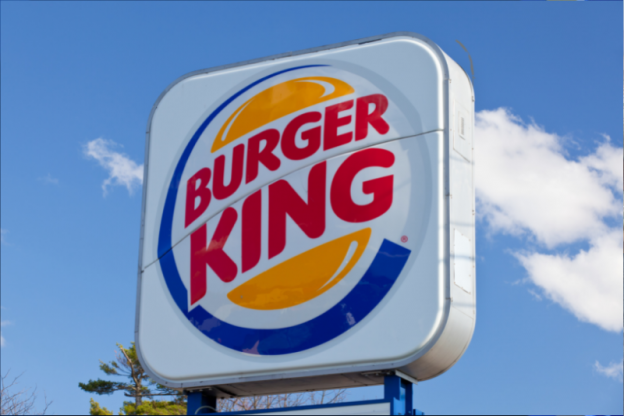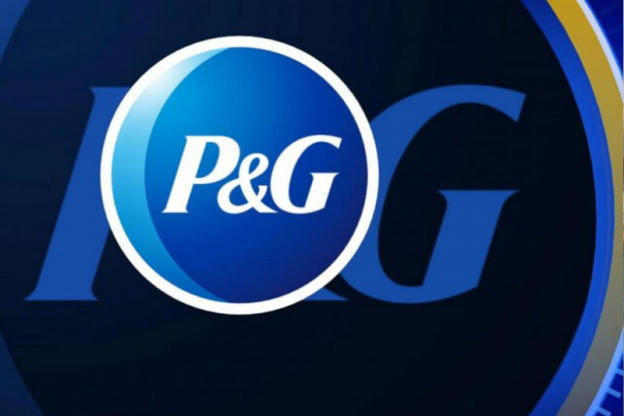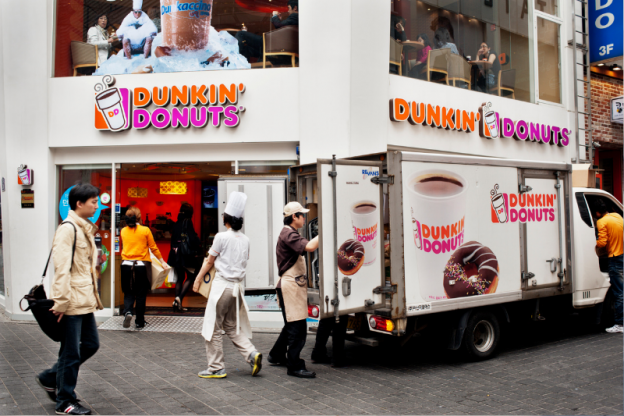This is a free Zara SWOT analysis available for all students. You should use it only as a reference.
Company Details
| Founded: | 1975, A Coruña, Spain |
| CEO: | Óscar Pérez Marcote (2011–) |
| Headquarters: | Municipality of Arteixo, Spain |
| Revenue: | 19.56 billion EUR (2019) |
| Number of locations: | 2,270 stores |
| Parent organization: | Inditex |
| Founders: | Amancio Ortega, Rosalía Mera |
If this century is the century of fashion and style, then we are all living in the age of Zara. This Spain-based global street fashion brand is one of the most sought-after companies in the world fashion industry. Apart from mounting revenue and surging appeal, the brand takes immense pride in its ubiquitous presence around the globe.
One of the things that make the Zara brand stand out from the crowd is its unending supply of new and exciting pieces of apparel twice a week. Customers know that they can get new and exciting designs for clothing which makes them come back again and again.
Another feather in Zara’s cap is its number of stores around the globe – over 2,220 retail stores in 88 countries.
If you need the latest and most accurate Zara SWOT Analysis, then our researchers can help you with that! We have a team of professionals that can compile a custom-made SWOT Analysis of Zara for you. Place your order now!
Zara SWOT Analysis
Through SWOT Analysis, researchers can find the most influential internal and external strategic factors that are either driving a brand’s success or running it into the ground eventually.
In the case of Zara, we can use SWOT Analysis to determine the comparative advantages and the inherent incompetency points through strengths and weaknesses.
For the external view, we will take into account the opportunities that Zara has at its disposal for growth as well as threats that can destabilize the retail fashion giant.
Zara Internal Factors
Internal factors are in the hand of a company that can either lend efficiency to the business model and operations or hampers its working at the optimum level.
💪 Strengths
Zara enjoys immense strength points when compared to its competitors. This gives the brand much-needed comparative advantages over other retail stores.
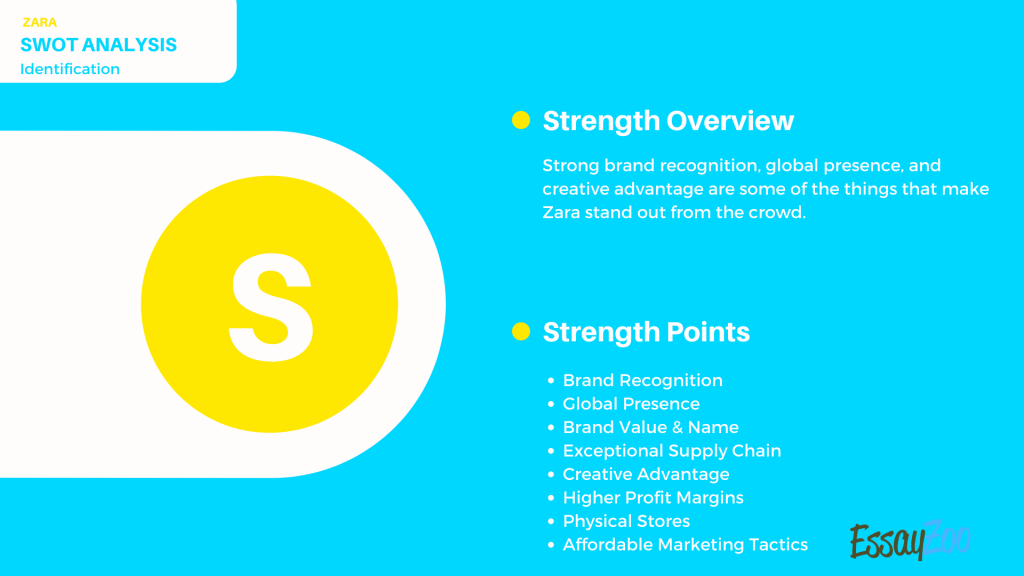
Brand Recognition
Whether it is the unmistakable logo of the Zara stores or its unending line of signature clothing and apparel items, Zara sports a strong recognition and belonging among its customers. With plenty of stores and fresh inventory every couple of days, the company never gets mixed up with its competitors.
Global Presence
Zara does not know when to stop its progress toward global hegemony. As of now, the company holds the record of having the most number of stores by a retailer around the globe.
Second to Zara is Nike which has almost half the number of stores as the company.
Through an aggressive global presence, the company is commanding immense revenue.
Brand Value & Name
When it comes to sheer brand value, Zara Store comes among the top hundred brands in the world by Forbes. Estimates put its brand value to be over $11 Billion. The immense popularity that the company enjoys and the consistent quality in retail fashion clothing helped cement its name and brand in the fashion world.
Exceptional Supply Chain
Zara has masterfully conquered the elements of insecurity and uncertainty in the transportation system. Where other brands take around one and half months to replenish their inventories in the market, Zara takes around fifteen days to bring the best and the brightest to its customers.
People always know that Zara makes and breaks trends and that’s why they flock around the stores.
Creative Advantage
Zara spends a fortune on designing, testing, and supplying thousands of new designs and apparel items to its stores around the globe. Its competitors often stick to introducing items during seasonal changes.
This gives Zara a creative advantage that the brand exploits a lot in generating revenue through fashion and basic apparel according to fashion trends.
Higher Profit Margins
Because of high sales and consumer satisfaction, Zara commands much hold on the cost of producing and shipping its merchandise. By rotating stock in Zara stores to generate revenue, the company takes high-profit margins from its business.
Physical Stores
This is where Zara shines through the roof. Instead of franchising its stores, Zara takes on partnerships with major local investors and steps into physical stores on its own.
This gives higher price and quality control as well as that profits and revenue.
Affordable Marketing Tactics
While having trendy stores and physical locations in major markets, Zara rarely relies on traditional marketing channels to grow its sales. The company also believes that its customers are its brand ambassadors.
🤒 Weaknesses
No matter what strengths a company commands over its competitors, there are always weaknesses in its operations and processes.
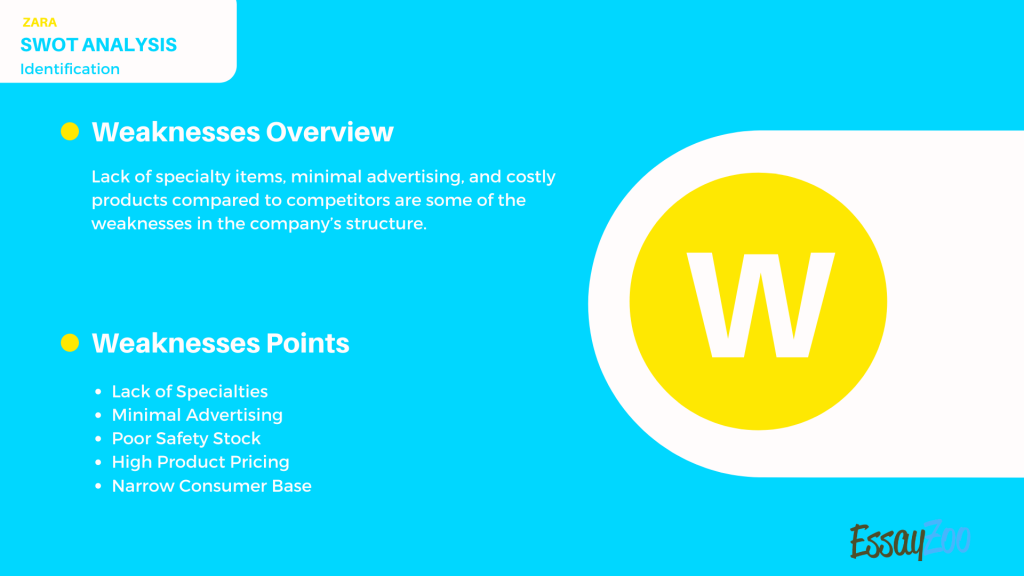
Lack of Specialties
Zara does not discriminate in its products at all. It makes everything for everyone all the time. This may be good for revenue generation but it leads to stagnation and monotony.
Minimal Advertising
Being the trendsetter clothing brand on the block, Zara can dramatically increase its sales numbers through aggressive advertising and online sales. Yet, the company still sticks to its cost model which is a strength and a weakness in itself.
Poor Safety Stock
Zara believes in minimal stock for fast fashion at stores because it allows the company to command enhanced consumer traffic. But there are inherent flaws in this policy.
The most important one is that there is no buffer or safety stock. In the case of a hit item or article, it will never reach its intended potential because there is no stock to back the added demand.
High Product Pricing
When compared to other brands, the pricing of brand Zara products is steeper. Although customers are willing to pay top dollar for top apparel, it makes the targeted audience a small demographic unit at any given time.
Narrow Consumer Base
Zara has now stores in over 88 countries. Still, the brand is struggling to make reliable revenue streams in the emerging markets. This is one of the biggest weaknesses in its business plan.
Zara External Factors
The external factors that are affecting Zara’s business are its opportunities and threats that can and will affect its business in the future.
🤑 Opportunities
These opportunities can ensure both short and long-term gains for the brand.
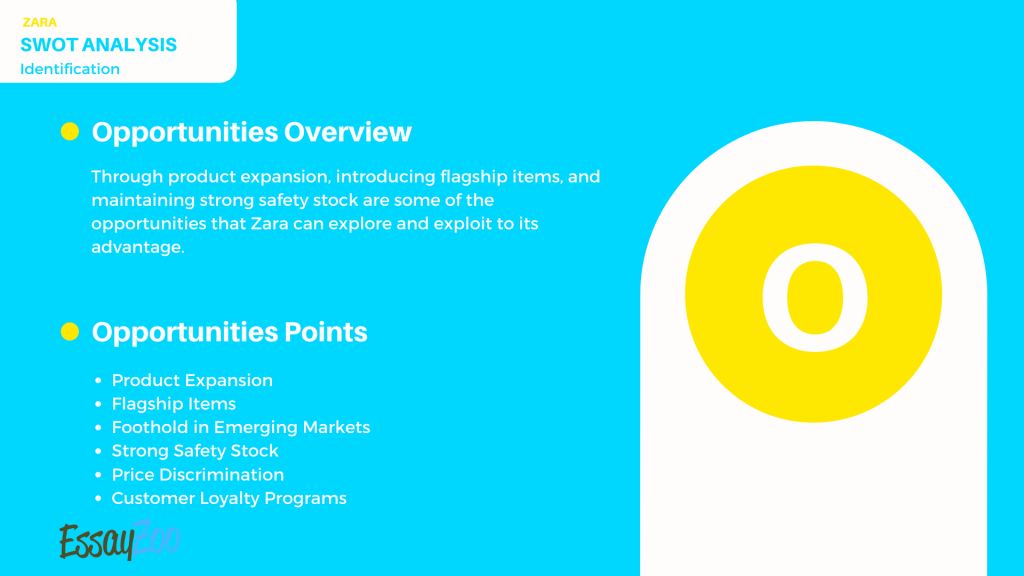
Product Expansion
Zara is now producing a vast range of clothing items. The brand can do much better by offering value-based product expansion for customers in emerging markets.
Flagship Items
Instead of relying on general and circulatory items to make a difference, Zara can introduce flagship items with safety stocks to realize the potential of hit items and articles.
Foothold in Emerging Markets
Emerging markets, such as China and India, can prove exceptional in the company’s expansion in the global arena. These economies offer much potential with low-cost sustenance.
Strong Safety Stock
By having safety or buffer stock, Zara can capitalize on the potential of hit or star items by offering more to its customers. With “bestsellers” in its store, the company can gain better margins.
Price Discrimination
Through price discrimination according to customers and markets, Zara can explore new streams of revenue which will help in replenishing its cash flow.
Customer Loyalty Programs
Through customer loyalty programs, the brand can boost its sales among current customers and prospects. This is another tool for price discrimination.
😨 Threats
These threats can seriously dismantle Zara’s name and fashion retail stores. This could result in the company going into survival mode instead of thriving.
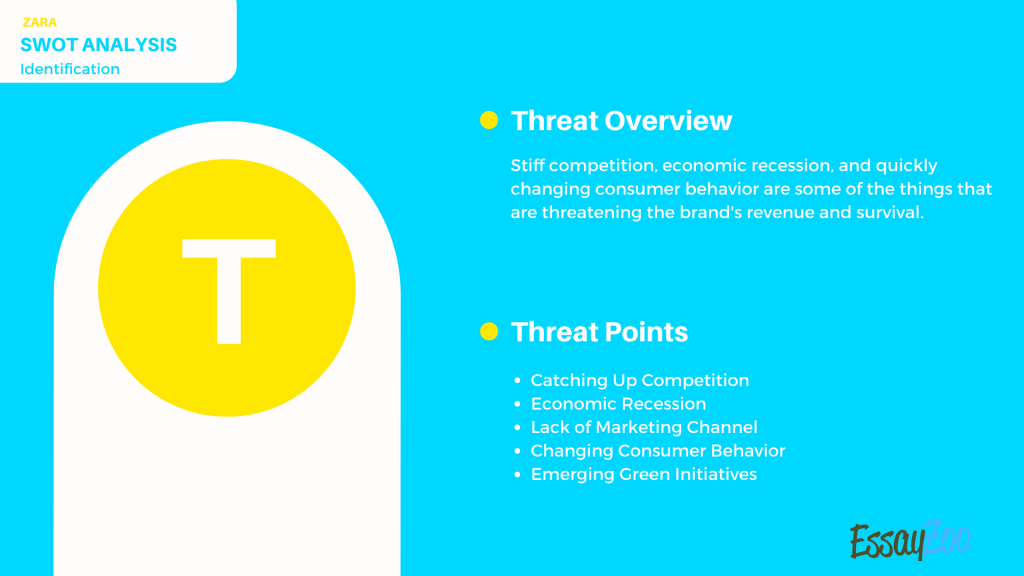
Catching Up Competition
H&M and Mango are some of the leading clothing brands that are direct competitors of Zara in the semi-premium category. Although the competition is not stiff at the moment, it will get in the foreseeable future with other fashion brands that can offer affordable prices.
Economic Recession
Due to the pandemic and the rising costs of living, people are thinking about spending their hard-earned money on trendy clothing. Zara is having the burnt of economic recession by having poor sales numbers and drying revenue streams.
Lack of Marketing Channels
Zara is one of the cost leaders when it comes to marketing expenditure. Experts believe this is a flaw in its business model because the company can lure thousands of new customers with its expert creative edge and supply chain system.
Changing Consumer Behavior
Recent trends and consumer behavior is changing. People are more concerned about what they think and the political and social affiliations of the brands they wear. Zara has always been humble and detached in its standing but still, people are growing weary of big retailers.
Emerging Green Initiatives
Clothing and fashion apparel are one of the reasons behind mounting plastic and fabric pollution. Even though other brands are major contributors in this regard, critics often do not discriminate and lumped them all up in one pile.
Zara SWOT Table
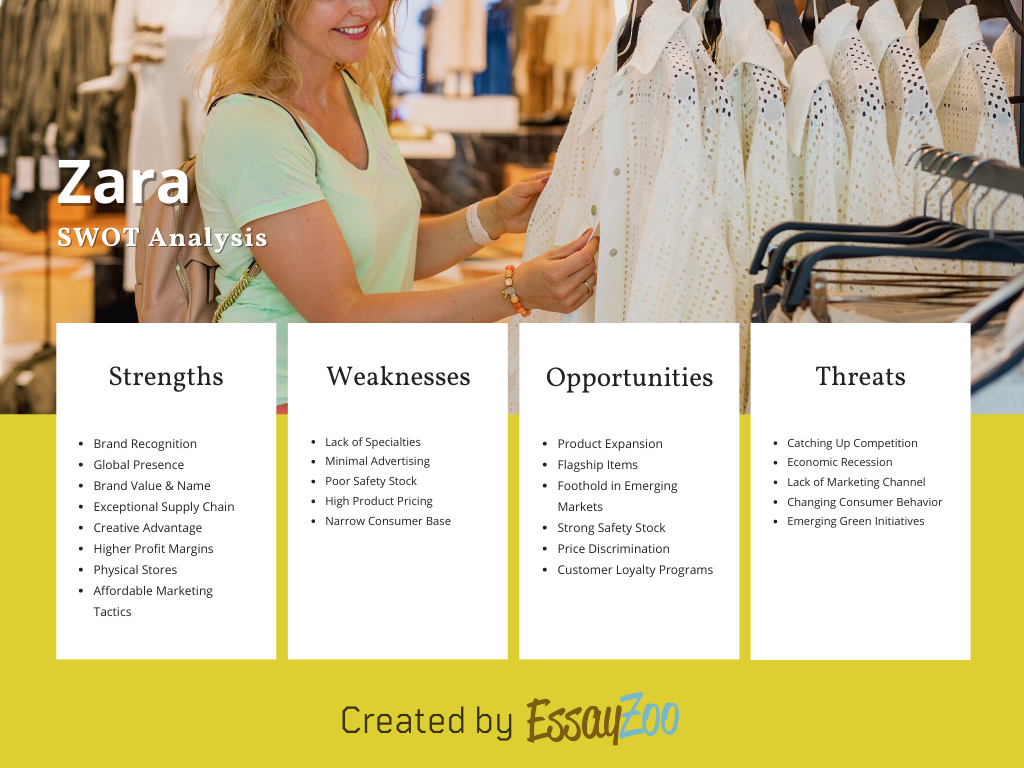
Strengths
- 💪 Brand Recognition
- 💪 Global Presence
- 💪 Brand Value & Name
- 💪 Exceptional Supply Chain
- 💪 Creative Advantage
- 💪 Higher Profit Margins
- 💪 Physical Stores
- 💪 Affordable Marketing Tactics
Weaknesses
- 🤒 Lack of Specialties
- 🤒 Minimal Advertising
- 🤒 Poor Safety Stock
- 🤒 High Product Pricing
- 🤒 Narrow Consumer Base
Opportunities
- 🤑 Product Expansion
- 🤑 Flagship Items
- 🤑 Foothold in Emerging Markets
- 🤑 Strong Safety Stock
- 🤑 Price Discrimination
- 🤑 Customer Loyalty Programs
Threats
- 😨 Catching Up Competition
- 😨 Economic Recession
- 😨 Lack of Marketing Channel
- 😨 Changing Consumer Behavior
- 😨 Emerging Green Initiatives
Read More:
- Netflix SWOT Analysis 2022: A Detailed Report
- Comprehensive SWOT Analysis of Procter & Gamble
- Best SWOT Analysis of Johnson & Johnson
- SWOT Analysis: Coca Cola
- Strengths, Weaknesses, Opportunities, and Threats of Nike
- Strategic SWOT Analysis of Airbnb
- SWOT Analysis of McDonalds Company
- Swot Analysis of Burger King’s Current Situation
- A SWOT analysis for Chick-fil-A’s company
- Apple SWOT Analysis
- SWOT Analysis for Disney – Free Example
- Walmart: Strengths, Weaknesses, Opportunities, Threats
- Facebook SWOT Analysis In 2022
- Free Tesla SWOT Analysis
- SWOT Analysis of Dunkin Donuts
- [2022] Google SWOT Analysis
- Informative SWOT Analysis of UPS
- In-Depth SWOT Analysis of Amazon
- Samsung SWOT 2022
- Toyota Company: SWOT Analysis
- Starbucks SWOT Analysis 2022

